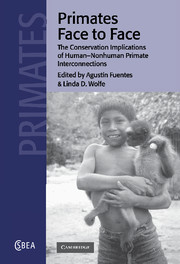Book contents
- Frontmatter
- Contents
- List of contributors
- Foreword
- Acknowledgements
- Introduction
- Part 1 Science and nonhuman primates
- Part 2 Cultural views of nonhuman primates
- Part 3 Conservation of nonhuman primates
- 9 Monkeys, humans and politics in the Mentawai Islands: no simple solutions in a complex world
- 10 Conservation must pursue human–nature biosynergy in the era of social chaos and bushmeat commerce
- 11 A cultural primatological study of Macaca fascicularis on Ngeaur Island, Republic of Palau
- 12 Monkeys in the backyard: encroaching wildlife and rural communities in Japan
- Part 4 Government actions, local economies and nonhuman primates
- Index
11 - A cultural primatological study of Macaca fascicularis on Ngeaur Island, Republic of Palau
Published online by Cambridge University Press: 20 October 2009
- Frontmatter
- Contents
- List of contributors
- Foreword
- Acknowledgements
- Introduction
- Part 1 Science and nonhuman primates
- Part 2 Cultural views of nonhuman primates
- Part 3 Conservation of nonhuman primates
- 9 Monkeys, humans and politics in the Mentawai Islands: no simple solutions in a complex world
- 10 Conservation must pursue human–nature biosynergy in the era of social chaos and bushmeat commerce
- 11 A cultural primatological study of Macaca fascicularis on Ngeaur Island, Republic of Palau
- 12 Monkeys in the backyard: encroaching wildlife and rural communities in Japan
- Part 4 Government actions, local economies and nonhuman primates
- Index
Summary
Introduction
The most eastward location of the long-tailed macaque, Macaca fascicularis, is on the Island of Ngeaur. The monkey population was estimated to be about 400 in 1994 (Wheatley et al., 1999), a population reduction of about half of the 825–900 estimated by Farslow (1987) in 1981. Ngeaur is one of sixteen States that make up the Republic of Palau. It is a small, 830 ha, raised coral atoll, one of the Republic's 350 islands (Karolle, 1993). This atoll is the only home for monkeys of any kind in the entire Pacific region of Oceania. The 150 people of Ngeaur (Rechad er Ngeaur), however, feel more cursed than blessed by the presence of monkeys. The people of Ngeaur hunt and trap monkeys, although they are not eaten. A previous paper examined the hunting and trapping techniques as well as the behavioral responses of monkeys to hunting (Wheatley et al., 1999). This chapter describes the rationale of the people for their disdain of these monkeys.
This species is a problem to local farmers throughout Southeast Asia (Wheatley, 1999). Despite problems that monkeys can cause, however, some possibilities for their conservation exist (Wheatley, 1999). Balinese conservation efforts at a Monkey Forest in Ubud are a success because the local community of Padangtegal eventually supported them.
- Type
- Chapter
- Information
- Primates Face to FaceThe Conservation Implications of Human-nonhuman Primate Interconnections, pp. 240 - 253Publisher: Cambridge University PressPrint publication year: 2002
- 7
- Cited by



